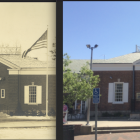News
New Canaan Now & Then: Lt. David St. John Home
|
The earliest real estate transactions regarding the parcel of land known as 46 Park Street date back to 1741.
Land Records report that “proprietors of Norwalk” sold two acres at the upper end of White Oak Shade Ridge (as it was then called) to John Betts in 1741. Betts in turn sold the property to his son in law, Henry Inman of Bedford, New York for £28. There is no mention of any dwelling in these early accounts, but when Inman sold the property to Jonathan Husted on November 8, 1742 the deed reflects a home and a shop on the property. The home originally had the entrance on the north side of the building, unlike its modern configuration of the front door facing Park Street. The four rooms on the ground floor level were built around a central chimney with three fireplaces.
In 1764 Lieutenant David St.





